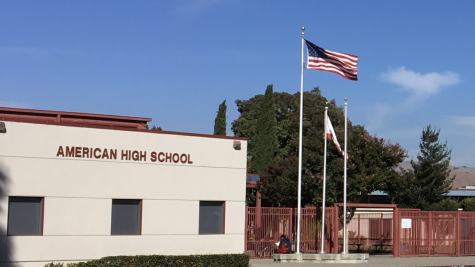Think Paly’s fire alarms are outrageous? Check out this school’s stats
American High School’s fight against the fire alarms
January 24, 2019

It was like clockwork. Friday afternoon would come, and the all-too-familiar tone of the campus fire alarm would sound. Except there was no fire — there wasn’t even any smoke. And yet every Friday after lunch, the Fremont Fire Department raced to the phantom fire at American High School.
It happened often — even more often than the now infamous fire alarms at Palo Alto High School.
Indeed, American stands out as having confronted an even more extreme version of one of Paly’s most pressing issues — the rampant and almost always unnecessary triggering of fire alarms.
[Related stories: “Voice study: Paly leads other Peninsula high schools in fire alarm frequency” and “Voice study: How far have Paly students walked responding to fire alarms?”]
During The Paly Voice’s investigation of the rate of fire alarms at Peninsula high schools from Sept. 1, 2014, to Sept. 1, 2018, Paly had the had the highest number of fire alarms of any school studied on the Peninsula. While San Francisco Peninsula schools were the main focus of the Voice study, American High School in Fremont attracted attention for having an unusually high number of fire alarms — 126 alarms in four years — according to data collected from the Fremont Fire Department. Comparing this number with data The Paly Voice collected from Palo Alto, Mountain View, San Mateo and Belmont fire departments, American High School came out on top in number of fire alarms — surpassing Paly by 25 alarms in the same four year period.
“It [the fire alarms] came in waves,” American High School Principal Steven Musto told The Paly Voice earlier this month.
The data collected shows a trend beginning in October 2016 with eight fire alarms going off in one month before falling off in November, December and January. The general trend increases through February 2017, before beginning to ebb in December.
“The worst of it was about four years ago during May, and we were getting it almost three times a week, but that was only for a couple weeks before we found who was doing that,” Musto said. “We were getting things on a weekly basis.”
Such a constant barrage of fire alarms began taking its toll on the school community, Musto said.
After lunch on Fridays, teachers began telling their students to be ready to leave, anticipating their imminent departure signaled by yet another false alarm.
“It is incredibly damaging,” Musto said of the false fire alarms. “Not only is it annoying, but it adds a stress level to everyone. When you hear that alarm, you fear the worst, and that was not good.”
For some American High School students, the constant false alarms caused confusion as students tried to discern whether the alarms were real or not.
“At the beginning, we were very scared,” American High School senior Yujie Kang said. “But after a few times, it was difficult to tell whether it really was a fire or a fire alarm drill.”
According to Musto, the false fire alarms were almost always the result of students deliberately setting them off as a prank. It began with a small group of students planning to set off the alarms on a specific time on Fridays — usually after lunch.
For the American administration, something needed to change. And it did — thanks to what Musto describes as a culture shift.
“It flipped from ‘it’s a funny prank’ to people getting really mad, and they said ‘if students are doing this, we’re going to go after them,’ so people became more inclined to talk to us because it was getting to a ridiculous level,” Musto said.
After one key fire alarm triggering, the perpetrators posted about their exploits on social media and other students shared the information with administrators.
The consequences were significant — “up to and including suspensions,” Musto said. “There was one situation where expulsion was done, but it was not for the fire alarms themselves. … For each of the situations, we also had a restorative process, so they understood the consequences and hopefully deterred them from doing a thing like that in the future.”
Handing out punishments is one thing, but ensuring that the alarms stay dormant is another.
“Since the last three years, the administrators go to every English class, because every student takes English,” Musto said. “We do a presentation with some basic school rules and things to know. And each year since then, we’ve included fire alarms and what the consequences are, so we make sure all students heard that.”
Today, American’s fire alarms have fallen silent. According to Musto, the school has not seen a single false fire alarm since last school year. For the staff and students at American, the fire alarms are no longer a joke.
“It’s not funny,” Musto said, “especially when someone in my position has to explain this to parents when their students have been pulled out of class for a prank. [It] is just hard to do.”









![A protester in a chicken suit wearing a taco hat with the words “Cluck Trump” at the “No Kings” Democracy Fair in Palo Alto on Saturday. Protestor Mary Chan said she and her husband are horrified at the state of science and medicine in America. “What he [Trump] is doing by defunding scientific research is destroying our academic medical centers, and he’s [Trump] bankrupting rural medical centers,” Chan said. “We will have lasting negative impacts on American health for decades.”](https://palyvoice.com/wp-content/uploads/2025/10/11562FFE-9912-4152-BB01-582426B52ECB_1_105_c-225x300.jpeg)